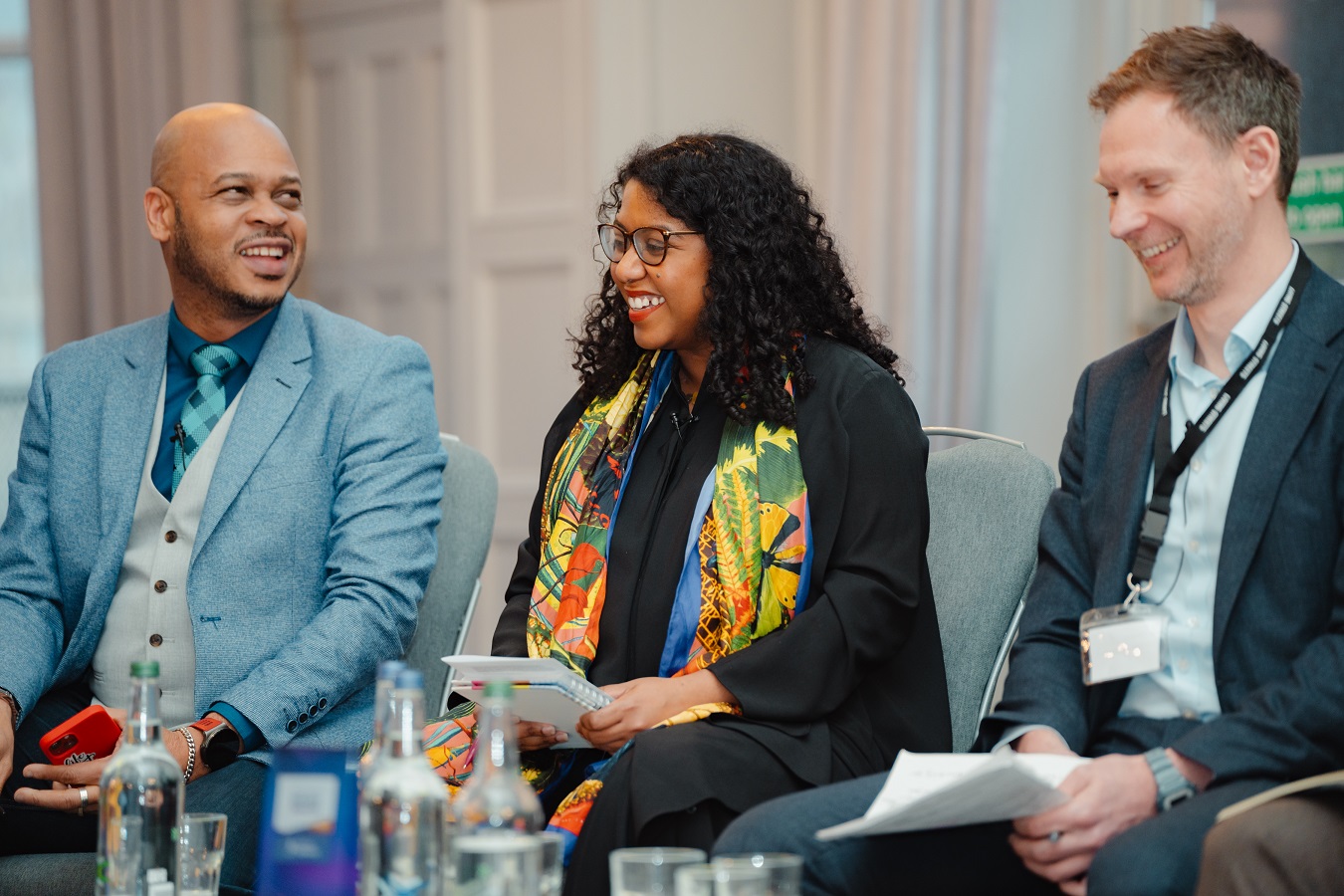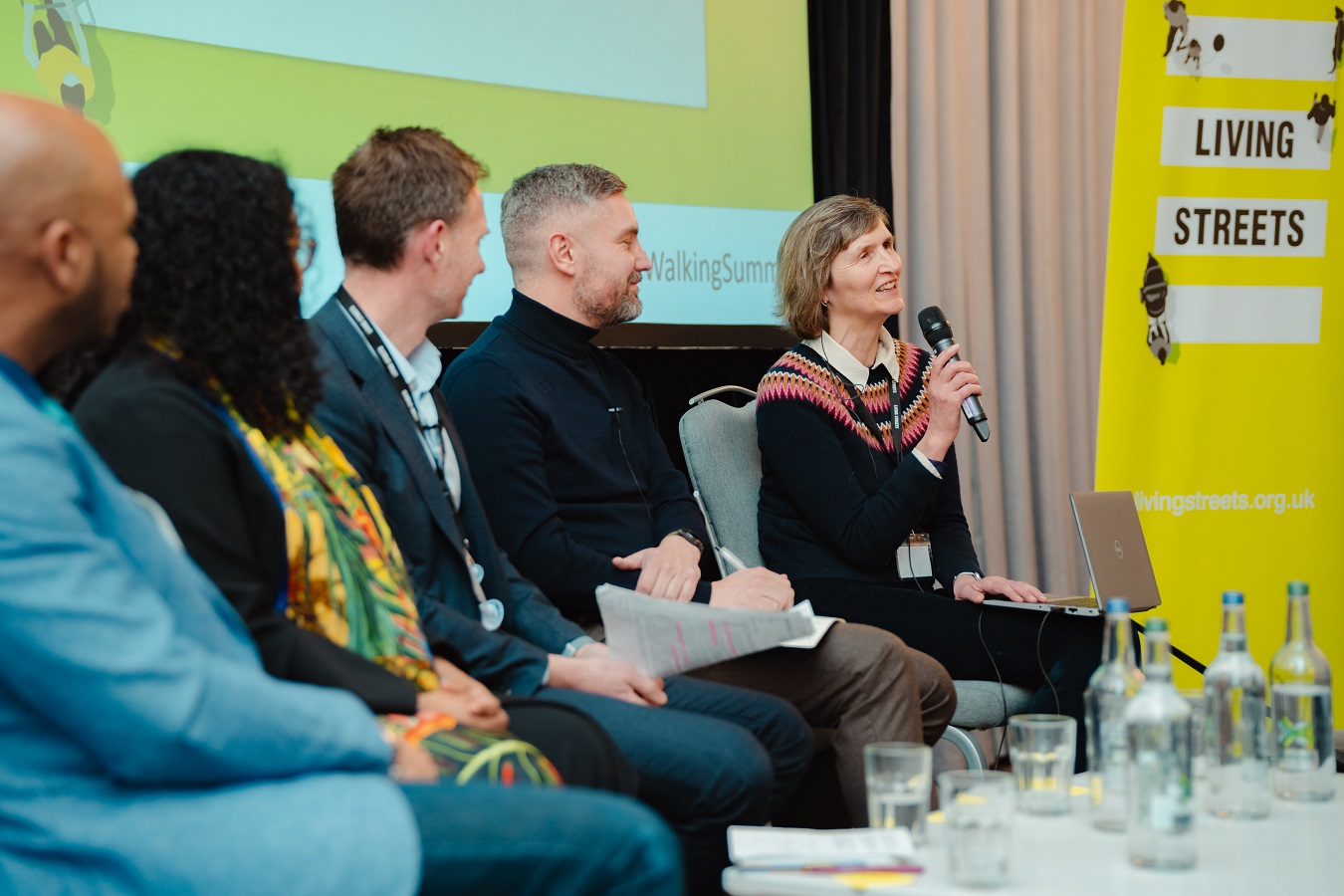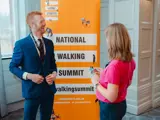UK Walking Summit 2024 takes to Sheffield
Living Streets’ UK Walking Summit 2024 took to Sheffield (7 March), bringing together UK leaders, international speakers and transport professionals who are reimagining our streets to be better places for walking. Dr Rachel Lee, our Policy and Research Manager, shares some of the discussion from the day.
Our 2024 Summit asked how we can demonstrate the value of streets designed for people and what impact investments in walking and wheeling have made so far on health, the environment and the economy.
Although it was the first time we had held our Summit in Sheffield, we aren’t strangers to South Yorkshire. Dame Jane Roberts, our Chair of Trustees, used the opening address to share some of our work in the region, including running WOW – our walk to school challenge, which has seen driving rates in South Yorkshire WOW schools reduce from 41% to 19.5% and one local school place in the top 10 most active WOW schools in England. There was also success for Living Streets the evening before, when our work in Yorkshire and the North East won a National Highways Industry Award.
Setting out the focus for the day, Jane told us that improving places for walking is a matter of social justice. The UK lags far behind our European Union neighbours, but only 2% of the transport budget is spent on walking. We need the right infrastructure and incentives – and community consultation – to make walking and wheeling the natural choice for short journeys.
Although there has been a cooling in tone politically towards active travel, we know that changes become accepted over time. So, the question for the morning plenary was: how can campaigners and officials work together to demonstrate the value of walking? Building on this, the question for the afternoon session would be: how can we meet walking targets and build active travel into new developments? The emphasis being on listening and including the widest possible group of people.

All images: Joe Outterside

South Yorkshire's Mayor, Oliver Coppard gives a warm welcome to the region
In a pre-recorded message, Guy Opperman MP, Minister for Roads and Local Transport, linked walking to a number of important priorities across Government – from health to high streets. He told us the Government remains fully committed to the vision that by 2030 50% of all journeys in towns and cities are walked or cycled
We were welcomed to the region by South Yorkshire's Mayor, Oliver Coppard, who told us that South Yorkshire is home to the first UK Investment Zone, the delivery of which will include high density development. He wants South Yorkshire to be the healthiest region in the UK. This is a clarion call to focus thinking, shift funding and shift mindset to achieve health, wealth and wellbeing across the region. He posed three questions to the audience and panel: how can we focus efforts on the least active? how do we ensure that walking has priority of esteem alongside other modes of transport? and how can we put walking into the heart of plans and funding?
Tom Hunt, Leader of Sheffield City Council, rounded off the warm welcome to Sheffield – ‘an optimistic city’. Before doing anything the council will ask – is it good for people, does it help secure our planet’s future, is it beneficial for the wealth of the city? There’s a new Transport Vision for the city – it’s an invitation to get involved to create better public transport and active travel. Active travel is at the heart of council approved plans for 20,000 new homes in the city centre.
Our morning panellists were given five minutes each to make the case for how we can overcome opposition and demonstrate the value of active travel projects.
Kerry Perruzza, Strategic Transportation Manager at Doncaster Council, told us change takes time and took us through the journey Doncaster has been on since 2016 when they took on a whole system approach across transport and public health. Their first Walking Strategy was adopted in 2018 with the aim of maximising investment across budgets. The emphasis has been connecting people and places - and listening to communities - but they need to get better at measuring success.
Cllr Mike Hakata, Cabinet Member for Climate Action, Environment, and Transport and Deputy Leader of Haringey Council, said that strong collaboration between local campaigners, residents and elected officials has been instrumental in Haringey - ‘you have to get out there and talk to as many people as possible’. Projects include thousands of walks delivered through Haringey Walks, the Road Danger Reduction programme, School Streets and Low Traffic Neighbourhoods.
And up next Julia Crear, Head of technical services at Living Streets talked about how Living Streets can help do that and invites delegates to find out more about our projects and how we can help councils and organisations engage with local communities.

Kerry Perruzza, Cllr Mike Hakata and Julia Crear

Ed Clancy OBE, Cllr Christine Gilligan Kubo and Matt Higgins
Ed Clancy OBE, South Yorkshire Active Travel Commissioner, reminded us that people don’t like being told what to do. That’s why SYCMA has invested in behavioural insight research, which asks key questions, such as: what support do people need and what opportunities do they have for change and what messages will resonate with them? It’s important to make sure no one is left behind. Can we measure change in the number of life years added or fewer doctors visits? The aim is to marry up the statistics with infrastructure change to tell a story that shows the value of active travel projects.
Cllr Christine Gilligan Kubo, Deputy Chair of the Transport, Regeneration and Climate Policy Committee at Sheffield City Council, told us there are massive health inequalities in Sheffield which could be addressed by encouraging people to walk more. 60% of journeys in the city are made by car, 40% of those are less than 1km – why is that? The Clean Air Zone has improved air quality, but bus services have not recovered from cuts during Covid. In her own Hillsborough ward the loss of bus services makes a difference to active journeys – it’s hilly! Small improvements, such as providing benches for pedestrians to sit and rest, can make a real difference. The city council has also invested in a massive programme to improve junctions and crossings.
Matt Higgins, Arup's Senior Transport Planner and Active Travel Lead for the North West and Yorkshire, spoke about the importance of talking to people about what matters most to them and broadening the range of people you speak to. He also challenged local authorities to factor active travel into their briefs, so that it isn’t added on afterwards as an expensive 'nice to have’.

Walkshops
As we know, walking is often the best way to discover an area. So, after lunch attendees headed out for a series of ‘walkshops’ around Sheffield.
My Living Streets colleagues, Roy and Jim, led ‘Riverside waymaking in the Don Valley’, which took in the successful river restoration and the redeveloped Victoria Quays.
Sheffield City Council showcased new neighbourhoods and approaches to street design on ‘Post-industrial reinvention: Kelham Island and Grey to Green’ and gave a tour of pedestrian areas, traffic removal and improved public realm in ‘Reimagining city centre spaces: Tudor Square, Fitzalan Square and Esperanto Place’.
Sheffield’s famous Park Hill featured on a walk led by Dr Jo Maher on behalf of South Yorkshire Mayoral Combined Authority and took attendees on a journey through the history of public health.
Wheels for Wellbeing discussed how to create equitable mobility for disabled people walking and wheeling in urban spaces in their walkshop, ‘Can we wheely get about?’ while Sheffield Environment Movement talked through using natural indicators to learn about air pollution on their led walk.
An in-venue session led by Living Streets Sheffield South West Local Group focussed on coming up with a 'flared junction strategy' for local campaigners. For attendees joining online, they either joined me in a workshop about bridging the gap between research and policy for inclusive streets or joined my colleagues to discuss how to work alongside communities for change.
Back in the room and feeling energised for our afternoon session. Our keynote speaker, Vishaan Chakrabarti, Founder and Creative Director at the Practice for Architecture and Urbanism, joined us live from New York to share his insights on redesigning transport for equity and inclusion. He asked the audience ‘what’s the future of the city?’ and showcased some of the work of his architecture practice on reclaiming spaces and making them places for human activity. He reminded us that people give places purpose. Many of the projects that he is working on are about creating places where people want to walk and are focused on building walking infrastructure into and creating connections to more deprived neighbourhoods.
The afternoon’s panellists were asked to make the case for how to build walking into new developments and integrate it with public transport.
Mark Corbin, Director of Network Resilience at Transport for West Midlands, told us their Local Transport Plan sets out three key outcomes – accessibility, electrification and reducing motor transport. Central to the plan is creating access to a fairer system where residents can move around freely and walk or wheel safely. It includes providing more choice, for example, through mobility hubs, cycle training and e-scooter trials. Transport for the West Midlands must listen to people or it won’t work and offer choice.

The afternoon panellists make the case for walking and wheeling

Mark Corbin, Sara Dilmamode and Wil Stewart
Sara Dilmamode, BAME Planners Network & Director at Plan In, outlined the role of planning documents, in particular local plans. These set out a 20-year plan for housing and growth – and the infrastructure that needs to go with it. Development management policies within the Local Plan set the rules and site allocations show where development and house building will take place. There are lots of best practice documents out there which tell you who and how to engage with people at different scales. Planners should make use of tools, such as Sustainability Appraisals and Equality Impact Assessments.
Wil Stewart, Director of Investment, Climate Change and Planning at Sheffield City Council, told us that Sheffield’s local plan aims to increase infill, reduce the need to travel and get more people walking. As we heard earlier – the plan includes 20,000 new homes for the city centre. We are told that the council want those new residents to engage with what the city centre has to offer and will be investing in green and blue infrastructure, talking to businesses and enabling walking to the destinations that people want to get to. ‘Catalyst sites’ on council owned land, will have more affordable homes and residents won’t need a car to get around.
Anna Lawson, Professor of Law at Leeds University, addressed the Public Sector Equality Duty (PSED) and the matter of making ‘reasonable adjustments’ for people’s inclusion in the public realm. She explained the role of PSED as a duty to think about the process of creating places – citing the Ali v Newham London Borough Council case (2012) where Newham’s own guidelines on the use of tactile paving fell short of national guidance expectations. In contrast, the need to make ‘reasonable adjustments’ is anticipatory of the outcomes of public realm interventions. The Women and Equalities Commission (and Lawson’s own work and a recent report by Transport for All) has raised concerns about shortcomings in this regard. Professor Lawson said that you need to include disabled people in the planning process to create inclusive public spaces.
Graham Grant, Director of Planning and Development at Active Travel England, told us that one of the key challenges we face is that planning is already seen to be delayed by the planning system. Active travel could be seen as another burden. He said that we need standardised expectations, so keep an eye on design codes – because standards have to be followed whereas guidelines can be ignored. In his presentation he said it’s not always about the money. We need to make more out of what we already have. But within the planning profession itself skills are being lost as people retire and young people are not attracted into the profession.

Mark Corbin, Sara Dilmamode, Wil Stewart, Graham Grant and Professor Anna Lawson

In summing up the day, Dame Jane Roberts spoke of her positive, warm feeling for the future. Yes, there are tricky challenges ahead in winning hearts and minds. But once people experience the difference they don’t want to go back. Politicians and political will are critical to making change happen.
The Walking Summit has shown what elected officers, working together with officials and many other people, can achieve. There is so much happening. When things are going well it doesn’t attract attention. We need to learn from each other and the value of working together and with communities. We all have something to contribute. We need to face opposition head on, at face value, listening and talking to residents. We should be collecting stories of what works in different places. Stories tell more than statistics.

Thank you to...
South Yorkshire Mayoral Combined Authority and Sheffield City Council for hosting our 2024 Summit;
Our sponsors Tracsis and Arup for their support;
(and again to SYMCA for this great video from the day!)
Throwing it back to last Thursday and our day at the @livingstreets #walkingsummit 🚶♀️@Ed_Clancy pic.twitter.com/i1pWD8noci
— South Yorkshire Mayoral Combined Authority (@SouthYorksMCA) March 14, 2024













About the author
Dr Rachel Lee
Policy and Research Manager, Living Streets
[email protected]